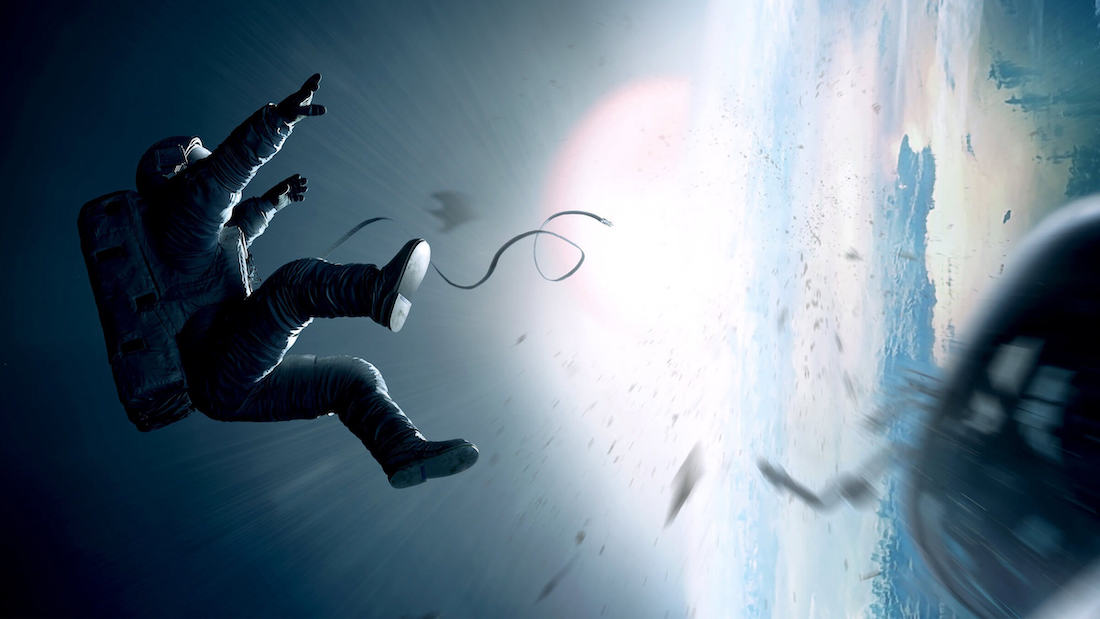By David Young · September 11, 2023

In every good story, the setting makes its own mark. This is especially true for Alfonso Cuarón movies. The writer/director takes the camera on a journey through imaginative worlds bursting with wonder and excitement, whether it’s the dangerous voice of outer space or a whimsical magic castle.
Whatever choices he makes in his writing or directing, Alfonso Cuarón has an appetite for lively settings that become characters themselves. This level of commitment to the stories he tells has become a trademark in his screenplays and films alike.
Read More: 10 Screenwriting Lessons from Alfonso Cuarón
You can feel utterly alone in any wasteland, any wide, open space — but outside the atmosphere, it’s even worse. Alfonso Cuarón captures that feeling of being small against the blackness of the void for Dr. Ryan Stone (Sandra Bullock). When the audience sees her in dire straits on the mission with her superior, the following tension comes not just from the hopelessness — but from the visual language that gives context. The setting here is a menacing, uncaring sort that stands against the main character as she grapples with dwindling hope and chances of survival. The filmic language from Cuarón does this quite well, but even within the screenplay, he pays tribute to the setting as its own presence.
Read More: 5 Plot Point Breakdown: Gravity
Download the script!
Named after the Colonia Roma neighborhood where the story takes place, this film is honest, intimate and very “slice-of-life” in comparison to many Alfonso Cuarón movies. This makes the setting a consistent decision-making tool for Cuarón as he depicts a semi-autobiographical picture of his old stomping grounds. Among other traits, it’s this intimacy and honesty — one that shows a setting held together by everyday, hardworking, unsung women in 1970s Mexico — that gave Cuarón such a potent canvas for his storytelling in movie form.
Download the script!
The visual majesty and whimsy of Hogwarts were well-known by the time Cuarón came into the picture. But while Chris Columbus delivered his Christmas-special treatment to the first two films, Alfonso Cuarón found something different, something deeper, to resonate with when he stepped in as director for the third film in the series. He filled the existing world of Harry Potter with darker humor and expanded the world using inspirations from the book and from the setting in front of him. From tracking a bluebird through the castle grounds to the mysteries that lead Harry himself to roam the halls, Cuarón’s own visual storytelling adds depth to the setting in a way the previous movies never explored. In various ways, he helped to make the modern Hogwarts a much more profoundly mysterious place filled with whimsy and dread — sometimes in equal measure.
Read More: 5 Plot Point Breakdown: Harry Potter and the Prisoner of Azkaban
Download the script!
The choices on Cuarón’s part for Great Expectations are mostly obvious — as an adaptation of the Charles Dickens novel, this story was meant for another city altogether. Yet the modernization onscreen turned this story into something intrinsically “New York.” With this change, the events take place in Pip’s life along a journey that mirrors what we see in the novel to an extent while allowing the film to become its own creation. As yet another adaptation of his to direct, Alfonso Cuarón does his part to breathe life into the existing ideas while giving the setting everything it needs to thrive for the audience independently.
Download the script!
As a sci-fi thriller with questions of its own to answer, Children of Men necessarily allows its setting to take center stage. With Alfonso Cuarón at the helm, this screenplay depicts what an infertile world looks like — and as he directs the film, he brings those words to life in a new, vibrant way. The chaos of this setting creates a lot of conflicts available to him as a storyteller. Cuarón uses exactly the right amount to garner audience interest time and time again as the problems of this dystopian existence start to unexpectedly coalesce. It’s with such masterful filmic ideas (on paper and onscreen) that Cuarón deftly creates a world that invokes such a desperate image in the minds of audiences almost 20 years later!
Download the script!—
As he moves with tenderness, skill and genuine interest across various genres, Alfonso Cuarón has become a storyteller with certain trademarks. One of his most impressive calling cards, though, is the way that the stories he writes or directs (in some cases, both) become showcases for the settings he’s built. It’s never just a setting, whether it’s through his own memory, his interpretation of existing fiction and worldbuilding, or even a backdrop of his own creation. Each time, the worlds he brings to the screen have their own fingerprint, their own power and their own character.
The settings have souls in Alfonso Cuarón movies — and it’s thanks to this skill that his stories continue to transcend genre and garner attention from various audiences in so many ways.